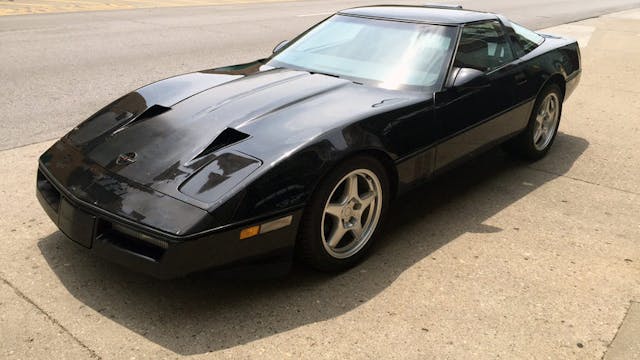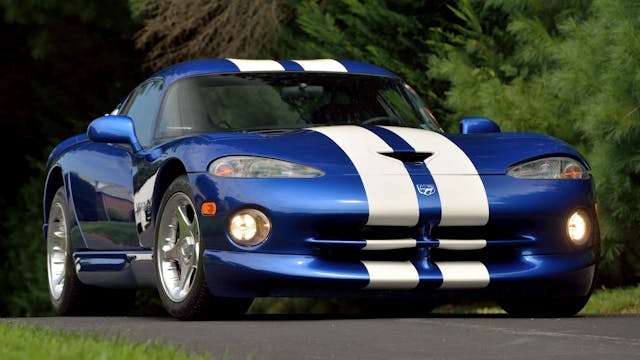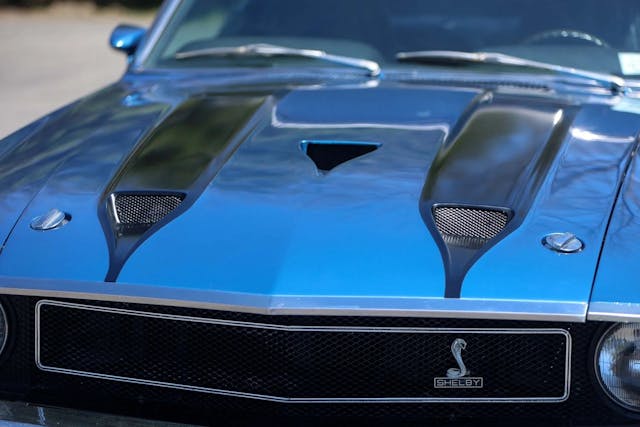The 10 coolest cars with NACA ducts
At the beginning of World War I, just 11 years after the Wright brothers’ first flight, the United States was lagging behind Europe in aviation technology. In an effort to catch up, Congress formed the National Advisory Committee for Aeronautics (NACA) on March 3, 1915. The organization, which would become the National Aeronautics and Space Administration (NASA) in 1958, reported directly to the president and began to develop wind tunnels to study streamlining and aerodynamics. The research rapidly increased the range and speed of American aircraft.
In the 1930s and 1940s NACA developed an airfoil design for wings and propellers that can be found on many important WWII aircraft including the P-51 Mustang. NACA contributed greatly to the first supersonic flight in 1947, achieved by Chuck Yeager at the stick of the X-1 experimental airplane, and thereafter turned its attention to missile technology and manned space flight.
Many of the organization’s aerodynamic achievements began to influence the design of automobiles, and the NACA ducts appeared on cars in the mid-1950s.
“In 1951 the original NACA report on it was declassified, and the design of the duct became public information, available for use by anyone,” wrote Motor Sport magazine in 2000. “Racing cars were an obvious application, but it wasn’t until 1956 and the emergence of Frank Costin’s redesigned Vanwall that someone had the nous to exploit it.”
That same year, small recessed scoops also appeared on the quarter panels of Ford’s Continental Mark II. They’re not exactly NACA ducts, but they’re close.
Developed in the agency’s wind tunnels, the low-drag air inlet submerged into the bodywork with curved sides and a blunt, squared-off end is still commonly found on race cars and high-performance production cars today. The NACA duct has become an iconic statement of speed.
Presented in chronological order, here are our picks for the 10 coolest high-performance street cars with NACA ducts.
1969–70 Ford Mustang Shelby GT350/GT500

Carroll Shelby didn’t have much to do with the Shelby Mustang by 1969; however, the car’s distinctive fiberglass hood with three NACA ducts assures both the GT350 and the GT500’s places on this list. The center scoop feeds the carburetor, while the two on the sides help draw hot air out of the engine compartment. The hot air then exits through two open vents closer to the cowl.
The hood design remained the same over the two model years, though the 1970 cars were actually leftover 1969 models and received black hood stripes for visual distinction.
1973 Pontiac GTO

This is the only muscle car from General Motors ever to wear NACA ducts. Two appeared in the center of its hood—and they were fakes. They did not feed the carburetor as originally intended but were instead blocked off by the factory. Allegedly, Pontiac did offer the rest of the prototyped induction system through dealers and about 10 cars with functional scoops were built. One is said to exist today.
Regardless, the muscle-car craze was quickly winding down by 1973, and the redesigned Pontiac GTO went over with a thud. The body style lasted just one year and Pontiac only sold just 4806, making it the worst-selling GTO of all time.
1974–90 Lamborghini Countach

Officially, we haven’t taken any measurements, but the award for the largest NACA ducts has to go to the Lamborghini Countach, which first appeared at the 1971 Geneva Auto Show and reached production three years later.
The mid-engine supercar features a single and sizable NACA duct on each side, beginning on each door and covering most of the quarter panels, feeding its massive radiators to keep its big V-12 engine cool. Production lasted until 1990 with nearly 2000 produced. Its successors, the Diablo, the Murciélago, and the Aventador, which just finished an 11-year production run, do not feature NACA ducts.
1980–86 Renault R5 Turbo

A homologation special for Group 4 rally competition, this little Renault is basically a Le Car with radically flared hips, rear-wheel drive, and a 158-hp, turbocharged 1.4-liter four-cylinder engine mounted in place of its back seat. About 5000 were built over six years. Two iterations, the Turbo 1 and the Turbo 2, each have a single, small NACA duct atop the left rear quarter panel.
The R5 Turbo was styled by Marcello Gandini at Bertone, who designed the Countach and penned many other machines featuring NACA ducts, including the Alfa Romeo Montreal and the Lamborghini Espada.
1987–96 Ruf Yellowbird

In 1987, Road & Track declared the Ruf CTR the world’s fastest production street car. It received its nickname “Yellowbird” during testing that year when it achieved a terminal velocity of 211 mph and accelerated to 60 mph in 3.6 seconds. It was powered by a twin-turbo, 3.4-liter flat six said to make 463 hp. The car cost $223,000. According to Ruf, 29 examples were built and 20 to 30 more were created from customer 911s.
If you haven’t seen the footage of this car drifting the Nürburgring, check it out on YouTube immediately. Look for its two large NACA ducts, one atop each rear wheelwell flare.
1987 Callaway Corvette

For many Gen Xers, the first car they remember with NACA ducts is the 1987 twin-turbo Callaway Corvette. Three years before the DOHC ZR-1, the most powerful Corvette was created with option code RPO B2K. It sent your new Corvette to Callaway Engineering in Connecticut, where its 5.7-liter V-8 was pumped up from with a pair of turbochargers and intercoolers.
Even sweeter were the two NACA ducts Callaway carved into Corvette’s hood. Sadly, however, they would last only one year. According to Callaway, 445 Corvettes were ordered with the RPO B2K option over the four-year run, so only 123 coupes and 65 convertibles featured the NACA duct hood.
1987–92 Ferrari F40

This was the last Ferrari personally signed off by Enzo himself. Built to commemorate the company’s 40th birthday, the successor to the 288 GTO featured a mid-mounted, twin-turbo 2.9-liter V-8 and two small NACA ducts in its front decklid.
It was the quickest, fastest, most expensive, and most powerful Ferrari of all time, with over 470 hp and a body made of aluminum, carbon fiber, and Kevlar. To save weight, the interior was race-car-raw, without door handles, glovebox, carpet, or sound system. The F40 was a stark contrast to its rival at the time, the all-wheel-drive Porsche 959. Just 1311 F40s were built, with a top speed just shy of 200 mph.
1996–2002/2013–17 Dodge Viper

This one needs a little more explanation. The original Dodge Viper, which went on sale in 1992, did not have a NACA duct in its hood feeding fresh air to its V-10 engine. In 1996, however, Dodge gave the sports car a bit of a facelift and introduced a coupe version called the Viper GTS.
The GTS was the first Viper with the large NACA duct in its hood, but Viper roadsters remained scoopless. An all-new Viper coupe and convertible arrived in 2003. Although a scoop remained in the hood of each style, it was not a NACA duct. This arrangement remained the lay of Viper land through 2010. The model left us for a little while, finally returning for a brief four years in 2013 as a coupe only … happily, with an aerodynamic NACA duct.
2008–15 Mitsubishi Evo X

This is the only four-door sedan on this list—the 10th and final generation of the Mitsubishi Evolution, a turbocharged and all-wheel-drive rally car inspired by the rival of the Subaru WRX STI. Known for its flared flanks and oversized rear spoiler, the last of the Evos also wore a single NACA duct in its hood. Although it wasn’t functional on the street-going model, the duct was put into use on Evos in rally competition. These cars were powered by a turbocharged, 16-valve 2.0-liter four-cylinder that made 291 hp and 303, in the Final Edition.
2009–2020 Nissan GT-R

NACA ducts did not appear on the R32, R33, or R34 versions of Nissan’s Skyline GT-R. However, they’ve been an important part of the aerodynamics and performance of the R35 GT-R, which was launched in 2009 and remains in production 14 years later. There have always been two on the supercar’s hood, and on 2019’s 600 hp GT-R NISMO, they were incorporated into the composite structure of the panel. They’ve never directed air into its boosted 3.8-liter V-6; instead, they duct cool outside air onto the engine’s twin turbochargers for cooling.
***
Check out the Hagerty Media homepage so you don’t miss a single story, or better yet, bookmark it. To get our best stories delivered right to your inbox, subscribe to our newsletters.



You missed the mustang SVO…
Not a NACA duct. Similar but not the same. NACA ducts by design are flat and not raised above the surface. The SVO Mustang had a raised dome.
No offense but you gotta love the fact the NACA is on the left side of the Renault and you pictured the right side!
What about the Ferrari BB512? I have NACA ducts very similar to the Lambo and the F40.
10 less recognized cars with NACA ducts:
1. Alfa Romeo Montreal
2. BMW Alpina e31 based B8 5.7
3. Porsche 924 turbo
4. 70 Shelby 350 & 71-73 Mustang Mach 1
5. Lamborghini Espada
6. Late 90s Dodge Viper
7. Lancia Stratos
8. ?
9. ?
10. ?
1. Alfa Romeo Montreal = YES!
2. BMW Alpina e31 based B8 5.7 = YES! another good one
3. Porsche 924 turbo = YES again!
4. 70 Shelby 350 & 71-73 Mustang Mach 1 = The 1970 Shelby was the first car listed here. The 1971-73 Mach-1 don’t have real NACA ducts.
5. Lamborghini Espada = YES! Great addition
6. Late 90s Dodge Viper = #6 listed above
7. Lancia Stratos = YES! Another good one
8 : First gen.1973 Alpine A310 4cyl.
What about the 81-83 280zx turbo? The functional duct feeds the turbo.
Forgot about that one! Good memory.
On an automobile, NACA scoops are really more of a styling affectation than an effective means of pulling in air. When I worked at Boeing, the aerodynamicists snickered at cars that had them because they really only became effective at higher airspeeds (not < 0.015 Mach) and were as much meant for minimizing ice buildup as drag.
NACA ducts sit flush so technically, they reside inside the low-friction boundary layer. This is good for anything producing moderate levels of vacuum because it avails you to non-turbulent airflow. On cars they are absolutely now better than the average factory hood scoops or cowl induction. The only scoops on American cars to have provided a clear edge with forced air are the 1969 1/2 A12 Road Runner and Super Bees with lift off fiberglass 6 Pack hood, and the 1970 Challenger T/A with fiberglass hood built for homologation into the SCCA Trans Am series. . All three cars had their scoop openings above the boundary layer receiving forced air. Everything else was just for cold air vacuum induction and looks.
Datsun 280zx, had about 7 of them…
I have had several myself. I still have a 83 turbo. I drive it to local cruse ins.
Nice, never had an s130 turbo only an 84ae z31.. Had 18 total, s130 and z31 cars.. Although my 18th was a z33. 04 auto roadster… What a great car.. Repeat cel problems though.
To the author, Scott Oldham … any relation to Joe?
My 62 T bird had a very functional yet subtly elegant hood scoop. They were on all bullet birds. Eventually Ford phased out the hood scoop into a fake hood scoop by 66.
What about the 68 and 69 Hutrst Olds
Ahhh… not even close
Add the Swift DB1 Formula Ford. The radiator inlets are NACA duct-shaped, but large.
https://flic.kr/p/2kCpysR
The last line of the story before the cars were listed said:
“Presented in chronological order, here are our picks for the 10 coolest high-performance street cars with NACA ducts.”
Not sure you can consider the Swift DB1 Formula Ford a “street car”
You missed the Pontiac Grand Prix GTX designed by SLP. It’s hood was actually functional (using that term loosely) too.
Another good one! I had a 2003 Pontiac Vibe with a functional SLP Ram Air hood:
https://www.novaresource.org/vibe/
Not factory but the same as that GP GTP
No, it doesn’t qualify, and you lose points for trying to get a free ad.
1979 AAR ‘Cuda?
1970
Not NACA
I did accept to see a TVR 2500M in the list.